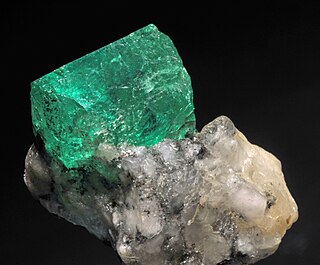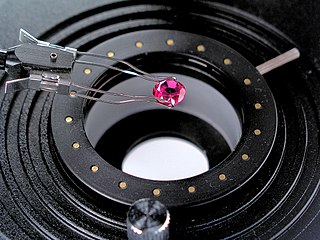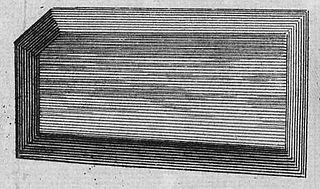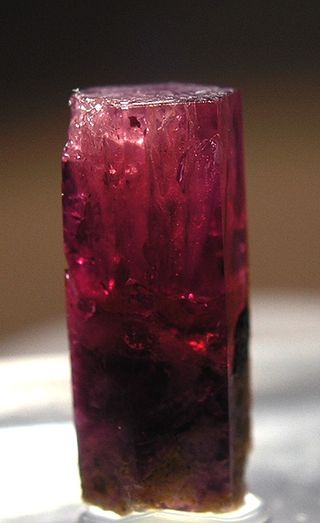
Emerald is a gemstone and a variety of the mineral beryl (Be3Al2(SiO3)6) colored green by trace amounts of chromium or sometimes vanadium. Beryl has a hardness of 7.5–8 on the Mohs scale. Most emeralds have much material trapped inside during the gem's formation, so their toughness (resistance to breakage) is classified as generally poor. Emerald is a cyclosilicate.

A gemstone is a piece of mineral crystal which, when cut or polished, is used to make jewelry or other adornments. Certain rocks and occasionally organic materials that are not minerals may also be used for jewelry and are therefore often considered to be gemstones as well. Most gemstones are hard, but some softer minerals such as brazilianite may be used in jewelry because of their color or luster or other physical properties that have aesthetic value. However, generally speaking, soft minerals are not typically used as gemstones by virtue of their brittleness and lack of durability.

Gemology or gemmology is the science dealing with natural and artificial gemstone materials. It is a geoscience and a branch of mineralogy. Some jewelers are academically trained gemologists and are qualified to identify and evaluate gems.
Gema or GEMA may refer to:

Founded in 1908, the Certified General Accountants Association of Canada (CGA-Canada) serves Certified General Accountants and students in Canada and nearly 100 countries. CGA-Canada established the designation's certification requirements and professional standards, offers professional development, conducts research and advocacy, and represents CGAs nationally and internationally. CGA-Canada joined the Chartered Professional Accountants of Canada to integrate operations under the CPA banner in 2015. CPA Canada is the new national accounting body formed by the merger of the Canadian Institute of Chartered Accountants (CICA) and the Society of Certified Management Accountants (CMA) in 2013, and now Certified General Accountants.
In gemmology, a Chelsea filter is a dichromatic optical filter used for identifying coloured stones.
Gemmological Institute of India is a gemmology training school in Mumbai, India.
The Swiss Gemmological Institute (SSEF) is a gemmology laboratory located in Basel, Switzerland. It is a part of the Schweizerische Stiftung für Edelstein Forschung. It was founded on an independent basis, by trade organisations, on August 22, 1972. George Bosshart, mineralogist and GG was the first director after the laboratory's opening in Zürich. Diamond grading was the major task and colour stones were tested rather exceptionally. In 1980 Bosshart hired Dr. Henry A. Hänni, Mineralogist and FGA. In 1994 Hänni moved the laboratory to Basel. He has been teaching gemmology at Basel university, and the close link to the university proved to be very enriching for both parts, academic and laboratory work. Hänni became professor of gemmology at Basel University, also a reward for his years of steady research and supply of publications. Prof. H.A. Hänni retired in 2009 and Dr. Michael Krzemnicki took over his position as a director. Dr. Krzemnicki has been working for SSEF since 1999.
The Gemmological Association of Great Britain (Gem-A) is an international gemmology education and qualifications body based in the United Kingdom.
Richard T. Liddicoat, Jr. was an American gemologist. Liddicoat was an educator in gemology, who made contributions in the area of diamond quality grading and gem identification. Liddicoat was the Chairman of the Board of Governors at the Gemological Institute of America (GIA).
ImaGem Inc. is a gem information company based on patented technology for grading and identifying gems. The parent company, ImageStatistics, offers applications in imaging and image processing for the medical, pharmaceutical, manufacturing, chemical and quality assurance industries. ImaGem was created after 20 years of research done on human perception and ImageStatistics, a statistical tool developed by Dr. Lalit K. Aggarwal. ImaGem’s Systems employ advanced optics, imaging technology and proprietary software programs to automate and integrate diamond grading. In addition to evaluating the 4C’s of diamond grading, ImaGem also analyzes Light behavior information based on precise and repeatable measures; three complementary dimensions of brilliance, intensity and sparkle. ImaGem has created a system of uniquely identifying and registering (fingerprinting) a stone without any need for laser inscription. By offering all this information, ImaGem has promoted decision-making and efficiency in the gem industry supply chain. In 1998, ImaGem Inc. was incorporated in the state of Pennsylvania, USA after funding from a major retailer, Ben Franklin Technology Partnership, and private funding. The company has developed an integrated technology to collect image data for diamonds and gemstones, analyze it using direct measurement methodology and grade for precise and repeatable measurements.

The Credit Institute of Canada (CIC) is a not-for-profit organization created by a special Act of Parliament on June 11, 1928. The CIC provides credit management resources, education and certification to its members and is the only organization that grants official designations to professionals in the Canadian credit management field.
The Canadian Institute of Gemmology (CIG) is a non-profit, post-secondary gemmological educational institution in Canada. The C.I.G. is dedicated to research and advancement in education in the field of gemmology. Their mandate is to provide gemmology-related training to the jewelry industry and the general public.

The Great Table was a large pink diamond that had been studded in the throne of the Mughal emperor Shah Jahan. It has been described in the book of the French jeweller Jean-Baptiste Tavernier in 1642, who gave it its name.
The German Gemmological Association (DGemG) is a nonprofit, technical-scientific association in the field of gemmology, located in the European gemstone center Idar-Oberstein. The two most important points of the statutes are the promotion of gemmology as science and technique and the development of information and education in the field of gemmology.

The Indian Diamond Institute (IDI) is a Government of India sponsored autonomous higher school of learning in the fields of diamonds, gems and jewellery in India. The Institute is located in Surat, Gujarat, India and is 263 km away from Mumbai. Indian Diamond Institute is an Authorised Assayer of Department of Customs, Government of India.
Gem & Jewellery Export Promotion Council (GJEPC) is an organisation set up by the Government of India (GOI) with aim to promote the Indian gem and jewellery industry and its products.

Golden sheen sapphire, is a recently discovered variety of corundum. Goldsheen sapphire has been tested and confirmed in lab reports as "natural sapphire" by GIA, GIT, GRS, AIGS, Tokio gem labs and Lotus.

Jack Ogden, FSA, FGA, is a British jewellery historian with a particular interest in the development of Materials and technology. He is considered one of the foremost experts in his field. He is the current President of The Society of Jewellery Historians, having held the position since February 2018, and was appointed visiting professor of Ancient Jewellery, Material and Technology, at the Birmingham School of Jewellery Birmingham City University in 2019

Red beryl, formerly known as bixbite and marketed as red emerald or scarlet emerald, is an extremely rare variety of beryl as well as one of the rarest minerals on Earth. The gem gets its red color from manganese ions embedded inside of beryllium aluminium cyclosilicate crystals. The color of red beryl is stable up to 1,000 °C (1,830 °F). Red beryl can come in various tints like strawberry, bright ruby, cherry, and orange.









